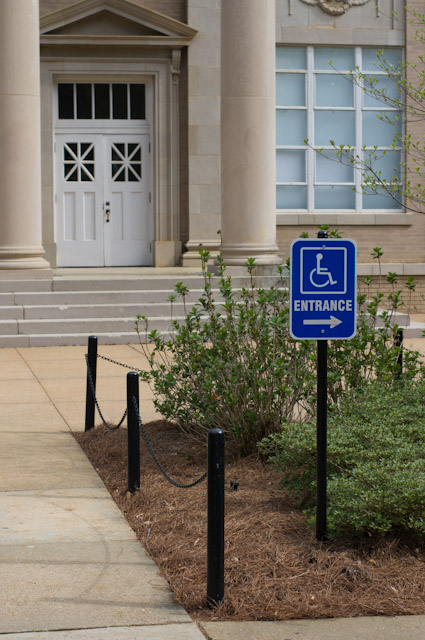In a December 2012 post to the TechNews blog, Deetra Wiley wrote about web accessibility and the importance of insuring that university websites and web services are available to everyone, but the requirements of accessibility are not restricted only to the administrative side of the university. We also have an obligation to insure that academic resources are accessible.
The university’s course management system, Blackboard Learn+, is fully compliant with Section 508 of the Rehabilitation Act issued by the US federal government and with the a Web Content Accessibility Guidelines 2.0 (WCAG) issued by the international World Wide Web Consortium (W3C). Unfortunately, that compliance does not eliminate the need for instructors to post compliant and accessible instructional materials to their Blackboard courses, particularly if that resource is only available via the web.
What does that mean for Instructors?

Front Door of Fulton Chapel with sign pointing to Wheelchair entrance. The University of Mississippi.
Accessibility in the classroom, whether traditional or online, is recommended regardless of whether a student has reported a disability to the instructor or not. Often students will not report their disability to their instructor because of social pressure or personal concerns. To provide access for those students, or to insure that your course is already accessible when a future student with a disability enrolls, instructors should integrate the three principles of Universal Design for Learning when creating instructional materials and assignments. Allow for a variety of ways for students to access the course content and to communicate their understanding of the content, consider differences in learning styles and be aware of accessibility issues from the outset when designing your course. Incorporating these principles will result in a classroom environment that allows students with a variety of abilities and differing strengths to participate and gain knowledge and skills equally, while eliminating barriers. The expectation for equal access to classroom resources applies to every course no matter the mode of instruction. Instructors who utilize web-resources to supplement their live class or to teach a fully online course have an increased burden to provide accessible resources, particularly if the resource is only available on the web.
Recommendations for Accessibility in the Classroom
- When considering new textbooks or instructional materials, ask the publisher for information about the accessibility of the materials and if they are available electronically.
- When photocopying articles for use in the classroom, avoid black edges and make the quality as high as possible.
- When showing videos in the classroom turn on closed captioning, or if listening to audio files have a transcript available.
- If you post your syllabus or an article in Blackboard, be sure that it is available as text, or link to the digital version of the article through the library’s website.
- When linking to videos through Blackboard that are required viewing for students, be sure that the video has closed captioning. The text in the captioning should be the same as, or very similar to what is being said and heard in the video.
- Any required links to audio files should also include a transcript file.
Conclusion
We all share responsibility for insuring equal access to resources for our students, whether in the classroom, on the web or in other less formal educational settings. Whenever we’re deciding which resources to use in our courses, accessibility should always be part of the process. Over the next year the Offices of Student Disability Services, Information Technology, and Online Learning will be working together to provide opportunities for the faculty and the university community to learn more about best practices for incorporating accessibility requirements into our classrooms and our institution.
Tags: Accessibility, Blackboard, universal design for learning